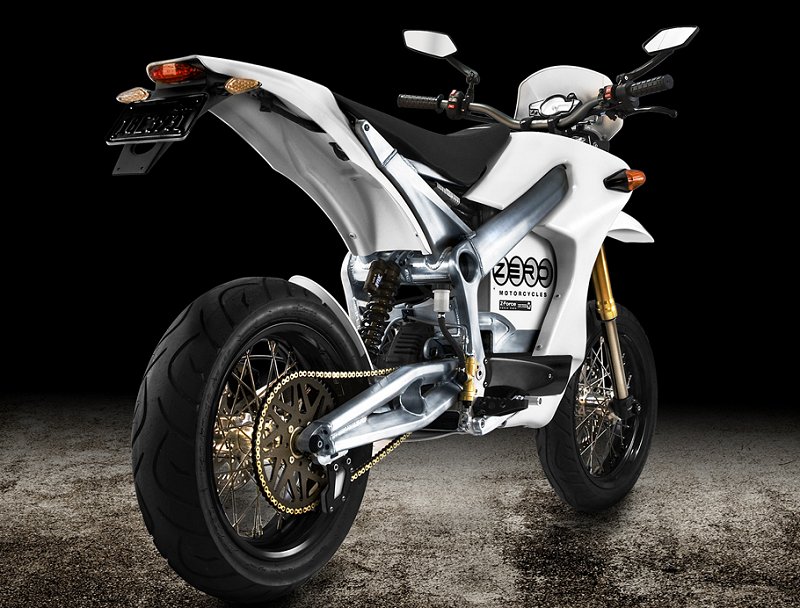
“Ssssssssssssssssssssssssss.”
That’s the sound of the future of motorcycling. Just a faint hissing sound as your tires roll along the pavement that gets a little louder when you apply the brakes. No staccato boom from the muffler of a big V-Twin, no more intake howl from an open-class literbike.
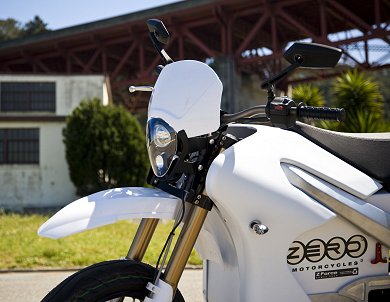
At least, that’s what designer Neal Saiki and CEO Gene Banman of Zero Motorcycles hope is the sound of motorcycling’s future. They are about to put their second electric motorcycle, the Zero S, into production, and I had a chance to try it out in San Francisco.
I’m starting this ride report off with a description of the vehicle’s battery because an electric vehicle is basically a battery with wheels. The motor, frame and chassis are all developed with the battery’s weight and capacity in mind. The S has a revolutionary, patent-pending battery design that uses 330 high-power lithium-ion cells (similar to what you’d find in cordless power tools) wired together. According to Zero, not only is it recyclable, it’s non-toxic and safe for landfill.
The chassis is a mix of cool and clunky. The frame is an elegant thing that weighs in at just 29 pounds. The rear shock is an adjustable Fox Racing unit intended for a downhill bicycle racer (Fox quit making motorcycle applications some years ago). The front fork, adjustable for damping but not spring preload, looks a lot like what you’d find on a Hyosung. Sun rims mount 16-inch Duro radial tires, a 110/70-16 front and 140/70-16 rear. That swoopy bodywork is recyclable ABS plastic.
This is my first review of an electric motorcycle, so bear with me here, as I’ve never given electric motors much thought. The Zero’s has brushes and a “permanent magnet.” I don’t know what that means. It sounds good. Peak input is 22,000 watts, which is much more than the battery can deliver, hinting of future upgrade possibilities. Zero claims it offers 31 hp and 62.5 ft-lbs. of torque. Not a lot of power, but that torque is available as soon as current is applied. Powerband? That’s so 20th-Century.
I showed up to ride the prototype in San Francisco’s Presidio, a National Park heavily patrolled by angry park police, so I knew this wouldn’t be a wild and crazy press intro. Banman was there to greet me and talk about the bike. After asking a few questions, I hopped on board.
The S feels similar to a standard supermoto, with a narrow frame and hard, skinny seat. The reach to the bars is too low for a supermoto; more like a mountain bike. But the seat was low, like the center of gravity, but the bike felt heavier to me than its claimed 225 pounds. The controls were normal motorcycle controls, with a key and all the controls and switchgear you’d expect, with a conspicuous lack of a tachometer or starter button. Switching on the key brings the instruments and lights to life, but nothing else happens.
Until you turn the throttle. Then the S lurches forward in eerie silence. The lack of feedback – there’s no clutch, transmission, drivetrain lash or engine feel – is spooky at first, like you’re coasting downhill with the engine off. The only sound was the whir of tires and a strange clanking sound coming from underneath. “What a piece of crap!” I thought, figuring some Chinese-built component was coming apart until I realized it was the chain, no noisier than an internal-combustion motorcycle’s chain, but “noisy” given the lack of any other noise. Banman told me that they considered a belt, but it had a tendency to slip off when jumping the bike.
I was expecting sharper acceleration from the claimed 62.5 ft-lbs. of torque. Instead, I found something more on par with a 250cc scooter. Not slow, but not quite the snarling wheelie-machine I expected. Banman says it’s because this prototype (which was not intended for product evaluation) is equipped with a 300-amp controller. Production machines will have a 400-amp controller (which will allow more current into the motor), but with the 300-amp unit I found both acceleration and top speed restricted; even with a long straightaway on the Golden Gate Bridge (the Zero S is legal for divided highways in California, as it has power exceeding that of a 150cc motorcycle) I couldn’t get the electronic speedo to read higher than 53 mph. The 400-amp unit should provide much quicker acceleration, and the 60 mph top speed Zero promises.
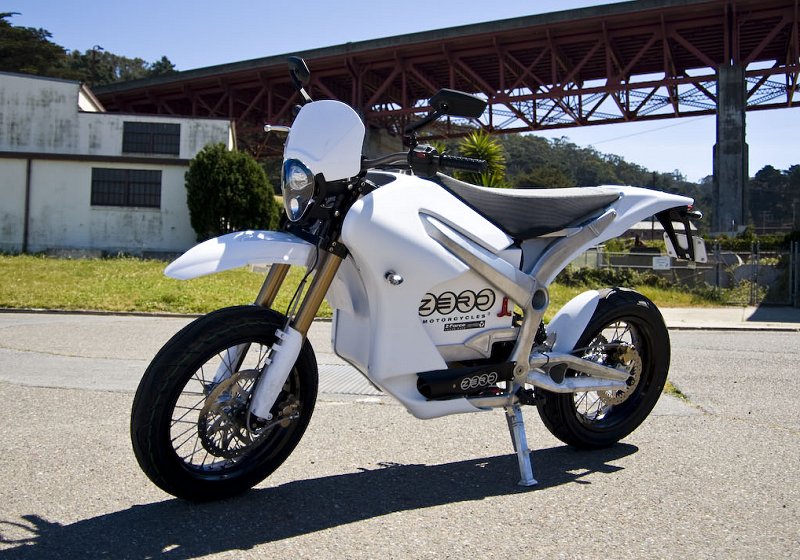
Ignoring the lack of noise and sluggish acceleration, the Zero felt like a regular motorcycle. Handling was nimble – 16-inch wheels, wide bars and 225 pounds mean bicycle-like steering – but stable and neutral as well. The seat wasn’t very comfortable, as it’s based on the X motocrosser’s, but Banman said other seats would be available. And although the brakes use floating rotors and braided-steel lines, they lacked power and feel. A supermoto’s rear brake should be sensitive and easy to modulate, but then again, this is no racebike, and Banman told me the production version will have “excellent brakes.”
I didn’t have a chance to really test battery performance, the $64 question of any electric vehicle. After about 20 minutes of hard use, I saw no appreciable dip in the charge gauge or reduction in performance. At mild around-town speeds, Zero predicts a 60-mile range. A full charge of a drained battery takes about three hours.
The 16-inch wheels seem an odd choice (Zero says it’s to reduce weight and unsprung mass) that limits tire selection. Despite the shortcomings of the S, after a few miles of tooling around, I forgot I was on an electric motorcycle and began to enjoy it for what it is: a lightweight, easy-to-handle and fun urban commuter that’s also economical and eco-friendly.
Is it economical and eco-friendly? Although Zero claims the operating cost is less than a penny a mile, that doesn’t’ factor in the cost of a new battery when the stock one wears out. But the lithium-ion cells have “no hysteresis at all,” according to Banman, meaning that charge capacity doesn’t depend on charging history, unlike other battery types (which can lose capacity if they are charged improperly). That means they can go 400-500 charge cycles if the battery is completely discharged each time. If it’s charged before the battery is flat, expect an even longer life . . . up to five years of average use, according to Zero.
But expect a hefty charge to your wallet when it’s time for a new battery: the smaller battery pack in the X is $2950, so expect the S pack to be 50% more. If you cover 30,000 miles in five years, that’s 15 cents a mile not counting the cost of electricity if a replacement battery pack is $4500. A 50 mpg motorcycle or scooter costs 16 cents per mile when gas is three bucks a gallon; making operating a Zero a wash, economically speaking. That’s if gas stays below three bucks a gallon, of course. And of course it will, right?
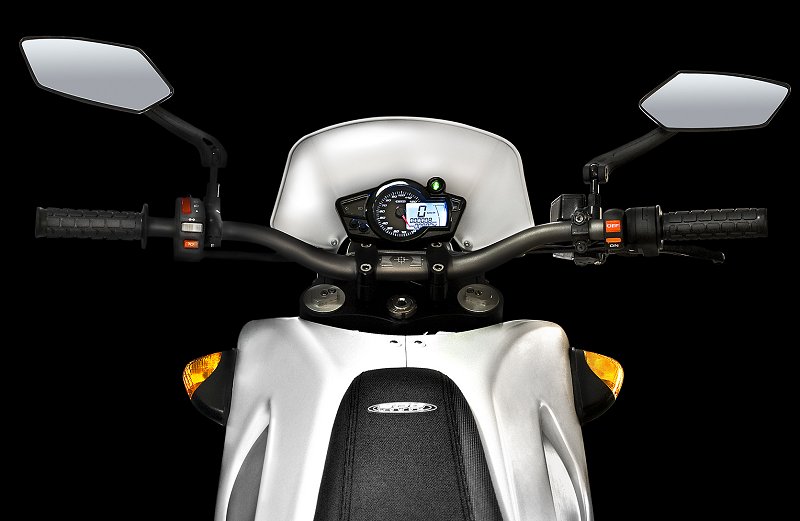
Environmentally, it’s a clearer winner. Even if the energy to charge your batteries comes from the dirtiest source possible, the efficiency of the electric motor and lack of power-robbing drivetrain components like a clutch or gearbox means less carbon emitted per mile than a gasoline engine. The icing on the cake, both ecologically and gear-head-wise is that Zero expects five to ten-fold gains in the energy density of batteries over the next five to eight years, so a replacement battery that offers a 300-600 mile range and greater top speed could be a bolt-in replacement. Can you imagine increasing the power of your bike ten-fold just by bolting on a new fuel tank?
But at present, the S doesn’t offer much performance for the $9950 pricetag, although it is partially offset by a 10% IRS tax credit for 2009, as well as a deduction for state sales tax and other state incentives. That’s a lot of money for what is really just a fast and fun around-town, errand-runner. But I think the Zero S could be a serious and dependable transportation tool for the right customer. It’s fun, cheap to operate (until that battery needs replacing), easy to ride and nicely made. Is it just a status symbol for smug eco-weiners? Zero says buyers of its bikes are mostly motorcycle enthusiasts who want another bike, with a few “green cool” customers who aren’t motorcycle guys, but are attracted to the eco-friendly nature of an electric bike. Zero expects to sell 600 S models this year (that’s how many frames it’s ordered), making it a serious mass-market product.
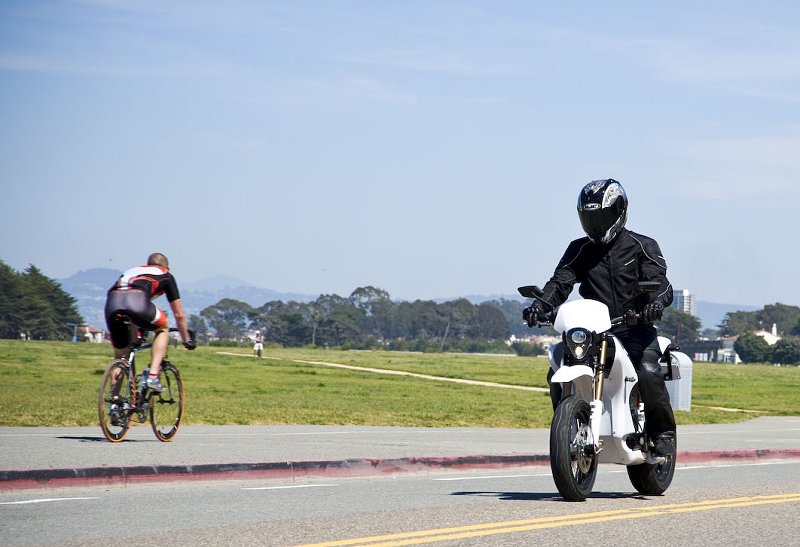
You can laugh at it or discount it as a silly toy for well-meaning but deluded enviro-wackos. But despite its shortcomings – and what two-wheeled product is perfect? – the Zero S is a serious motorcycle. It’s the first electric bike I’ve reviewed, but I know it won’t be the last.
MD Readers Respond:
- Thanks for a nice story. Don’t forget that with the internet you can make it longer.
Tell the Zero people to emphasize low maintenance in their design. Tubeless tires, sealed electrics, LED lighting, belt drive, etc. Saddle bag mounts are a must. And you can use them to hold extra flat pack battery power. Make it possible for the customer to configure the machine for their own intended use (you might learn something). The current “disposable” design is only good for a wealthy teenager. Donald - I enjoyed your report, Gabe. This actually looks and sounds (from your report) like a rather serious product.
I suspect that there is lots of potential for electric vehicles. Success of the electric motorcycle or automobile probably depends on enough people being convinced of that potential to motivate the development.
People laughed when Japanese manufacturers entered their first motorcycles in competition, but just because early results look a bit silly and we cannot imagine it really succeeding does not mean that it won’t. -kg
- Indeed, as battery technology ramps up, certain things will happen:
Capacity will increase (as you touched on)
Charging time will decrease
Motor efficiency will increase
Design to accommodate the battery will change the way the bikes are
designedEco-wienies may be the buyers now, but that wil change as gas goes up.
The real noise will happen when an electric bike outperforms a gas-
powered bike, especially on a track.Thank god you can’t put open pipes on them. Bill
- I am laughing at it as a silly toy for well-meaning but deluded enviro-wackos…. I do love your site though. Greg
- Thank you for covering this interesting bike. Might I make a few comments? First, it should have the rear brake control moved to the left hand grip, so that the rider could have greater control over the rear brake. I agree that its main strength, for now, is as a commuter, so they should add some storage or bags of some type. Until battery-charge density improves markedly—and acceleration along with it, they have a dandy commuter and fun city bike. It really is a one-speed scooter-type bike no matter how it is styled or marketed. Glen
- i’m a hardcore environmentalist.
i want a clean planet. i get pissed off that people
keep using regular paper when i know from experience
there is 100% post-consumer recycled paper that is a
bright white, strong, and prints beautifully – people
forget that trees are the lungs of the earth. its
lungs.so why did i just get up from my restful bed and got
off my butt to write this?because i long ago realized that motorcycle daily is
one of my favorite places, ever, to go read about bike
racing and bikes.and this guy, Gabe Ets-Hokin, that wrote the article
about the e-cycle ZERO is a liar. it’s there: it’s
published: he’s a liar. in the second paragraph of his
article, he says something like since he’s reviewing
an e-bike for the first time, he’s going to start with
the battery.that’s bull. liar. that’s your second paragraph!
c’mon, what did you REALLLLLLLLLYY start the article
with!as a matter of fact, you even picked up on the same
subject (was it Ssssssssssssssssssssssssssss or
vrooooooooooooooooooooooooom?) later in the article.
liar, liar, liar.me having grown up in a catholic country when i was
younger, i understand, however, the basis of
confession. and being a little bit of a psychologist,
i’m going to venture a guess. Gabe: when you wrote
Ssssssssssssssssssssssssssssssssss, it’s because our
hearts go Vroooooooooooooooooooooooooooom.By the power vested in me by the combustion engine, i
hereby absolve you of all your writing sins (IF any),
ever.As for the real guilty parties, here’s your penance:
people that wanna commute, can go ahead and buy
e-cycles. i might too. and will probably love them.
relatively speaking.people that just about more than anything want a MOTOR
cycle, like me, will make dam’ sure we got someting
that goes vrooom. even when we’re sleeping next to it
in the desert. we know the songs it sings when we wake up. Andrea - Expensive eco toy for try hards….
couldn’t even find a proper shocker?
$3k for batteries…?
seriously, who in their right mind is going to favor one of those over a
“proper” motorcycle?
not I sir! alby - I read your article on the Zero S.
I have a stupid question, doesn’t it make more sense to just use a 15-
kg bicycle with a serious charging motor instead of “developing” on
this heavy beast of over 100kg frame to make electric-bicycling a
reality and practical means of transport?If the traveller wants more speed, sure, put up a high power batter
and motor and also reinforced frames and wheels. This should still
weigh less than 50kg in total. If you really want to do a road
trip…well that is another story and another beast altogether.Bolting on a electric motor and Li-Ion batteries to an existing
dinosaur heavy bike (the Zero looks like a baboon), just seemed to be
so “harley technology”…outdated and dumb. This is hopefully not
called “invention” I hope. Did the Americans not learn that big is
not the new beautiful? 5000cc truck? Tan





